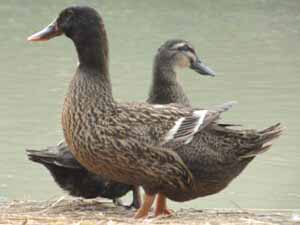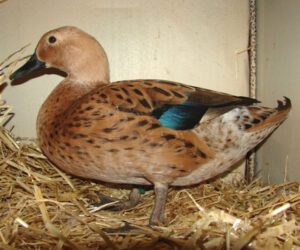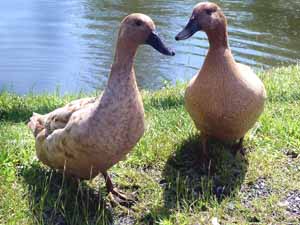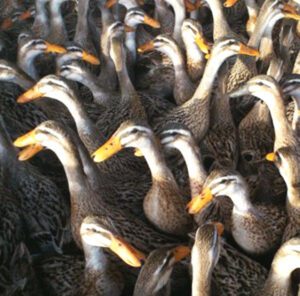The Indian Runner duck is an unusual and extraordinary looking breed of domestic duck. The breed is native to the Indian-sub-continent and was found on the Indonesian islands of Bali, Java and Lombok.
Although their name is ‘Indian Runner duck’, but there is no evidence that they came originally from India itself. Probably they were originated from the East Indies – Java, Lombok and Malaya.
The term ‘Indian’ may well be fanciful, denoting a loading port of the transport by ‘India-men’ sailing ships of the East India Company. Such misname happened with many other breeds of waterfowl imported into the America and Europe.
For example, the African goose (which is actually not from Africa), the black East Indian duck (which is actually not from India) and the Muscovy duck (which is actually not from Moscow).
The Indian Runner duck has a long history as evidenced by ancient Javan Temple carvings. Which indicates that the Indian Runner type ducks existed in Indo China, 2000 years ago. People in this area have been raising ducks for hundreds of years.
They trained their ducks to forage on the paddy fields and look for grain, weed seeds, insects, larvae, snails, small reptiles etc.
However, the Indian Runner duck became popular in Europe and America towards the end of the 19th century, as a good egg laying duck breed. It’s recorded that the first Indian Runner duck was imported to the United Kingdom during the 1830s.
But it was then known as the ‘Penguin Duck‘, mainly because of their incredible upright stance. The breed is recognized by both British Waterfowl Standards and the American Poultry Association’s Standard of Perfect.
Today the Indian Runner duck is mainly raised for their eggs production. And many modern duck breeds have been created from the Indian Runner duck. Abacot Ranger, Khaki Campbell, Welsh Harlequin etc. are good examples.
Indian Runner Duck Characteristics
The Indian Runner is a light weight breed of domestic ducks. They have slim body and long neck. Their long neck has prompted the description of a ‘wine-bottle’. They have slender head with eyes set high and their bill is straight.
The legs of the Indian Runner duck are set far back on their bodies, resulting in the upright carriage appearance of the breed.
Some Indian Runner ducks stand fully upright when agitated. But typically their carriages are 45 to 75 degrees above the horizontal. Their height (from crown to tail tip) ranges from 50 cm (20 inches) in small females to about 76 cm (30 inches) in the taller males.
The drakes have a small curl on the tip of their tails. But the ducks have flat tails. And it’s very difficult to determine the ducks and drakes until they are fully mature.
The Indian Runner duck appears in many color varieties than any other breeds of domestic duck. 14 color varieties are recognized by the British Waterfowl Standards. Which are Apricot Dusky, Apricot Trout, Black, Blue, Blue Dusky, Blue Trout, Chocolate, Cumberland Blue, Fawn, Mallard, Silver, Trout and White. And 8 color varieties are admitted into the American Poultry Association’s Standard of Perfection.
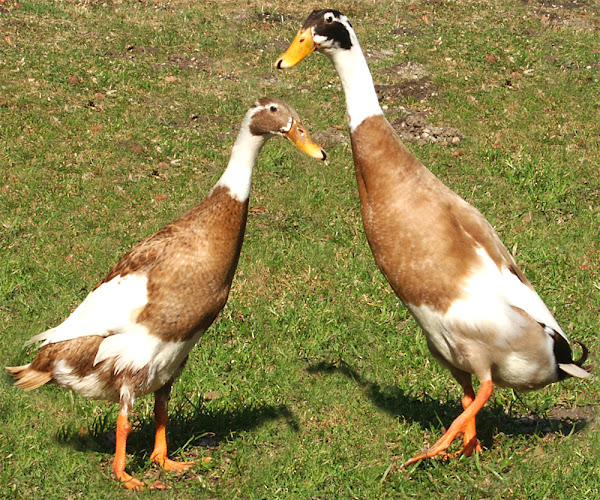
APA recognized color varieties are Black, Buff, Chocolate, Cumberland Blue, Fawn, Gray, Penciled, White. Average body weight of the Indian Runner duck is between 1.4 to 2 kg. And the drakes are slightly larger than the ducks. Average body weight of the drakes is between 1.6 and 2.3 kg. Photo from Wikipedia.
Uses
Indian Runner ducks are utility birds. They are exceptional egg layers. They are mainly kept as an egg laying duck breed and are also good for organic pest control.
Special Notes
The Indian Runner duck is a very active and docile breed of domestic duck. They are excellent foragers, probably the most active forager of all breeds and are good for organic pest control.
While foraging, they usually cover a large area in search of seeds, insects, slugs, snails and other edibles. They are always in a hurry. Indian Runner duck is an excellent egg layer and can outproduce any chicken in number of eggs laid per year.
They usually lay up to 250 eggs per year. But the best of them can lay up to 300 eggs per year. Their eggs can vary in color, but are often greenish-white in color.
This duck usually require less amount of water as compared to other duck varieties. And they can get by with just a tub of water in which to dunk their heads. They can be rather jumpy at times, but usually have a good nature.
And they are average in terms of noise level. Average lifespan of an Indian Runner duck is about 8-12 years. However, review full breed profile of this duck breed in the following chart.
| Breed Name | Indian Runner |
| Other Name | Penguin Ducks, Bottle Necks, Runner Ducks |
| Breed Purpose | Eggs, Organic Pest Control |
| Special Notes | Active, Docile, Excellent Foragers, Excellent Layers |
| Breed Class | Light |
| Broodiness | Poor |
| Drake | 1.6 to 2.3 kg |
| Duck | 1.4 to 2 kg |
| Climate Tolerance | All Climates |
| Egg Color | White, Greenish-White |
| Egg Size | Large |
| Egg Weight | 65 to 80 grams |
| Egg Productivity | Excellent |
| Flying Ability | Poor |
| Rarity | Common |
| Varieties | The Indian Runner duck appears in many color varieties than any other breed of domestic duck. 14 color varieties are recognized by the British Waterfowl Standards. Which are Apricot Dusky, Apricot Trout, Black, Blue, Blue Dusky, Blue Trout, Chocolate, Cumberland Blue, Fawn, Mallard, Silver, Trout and White. And 8 color varieties are admitted into the American Poultry Association’s Standard of Perfection which are Black, Buff, Chocolate, Cumberland Blue, Fawn, Gray, Penciled and White. |
| Country of Origin | Believed to have originated in South East Asia, probably the islands of Indonesia. |


